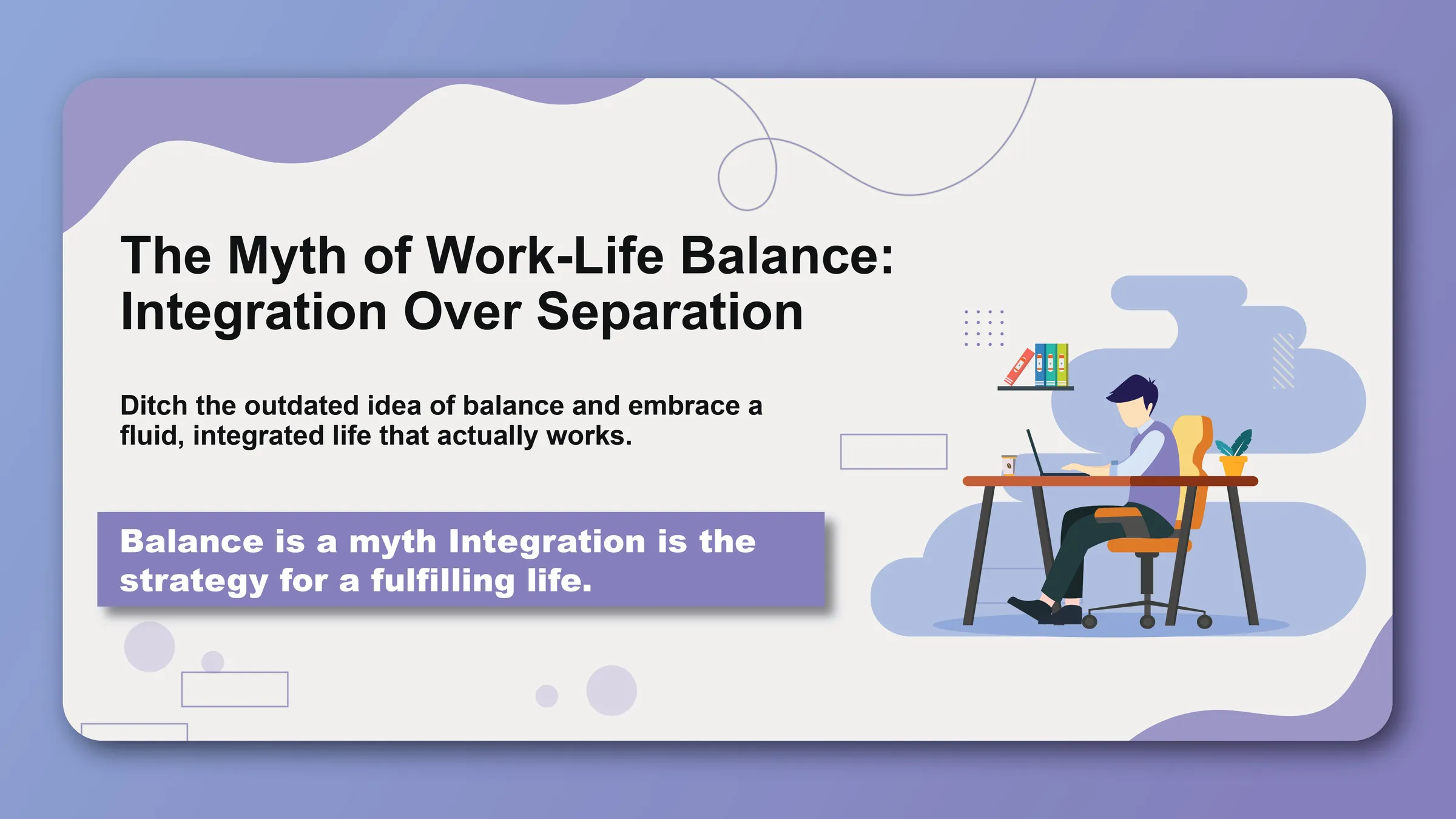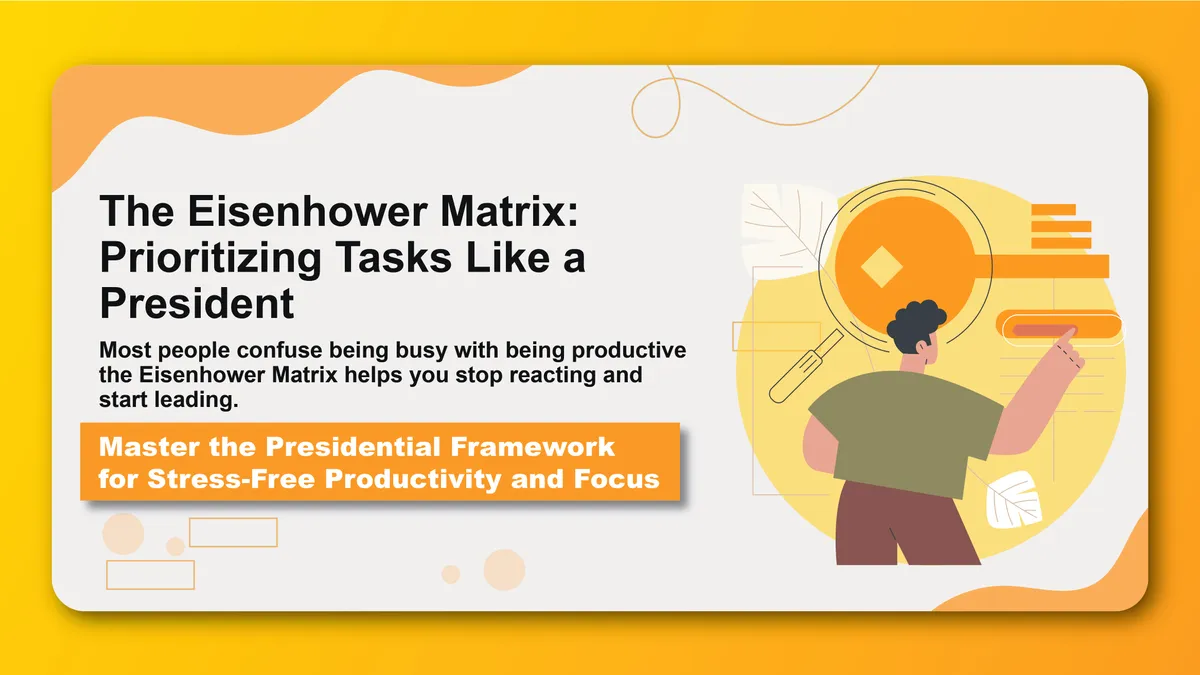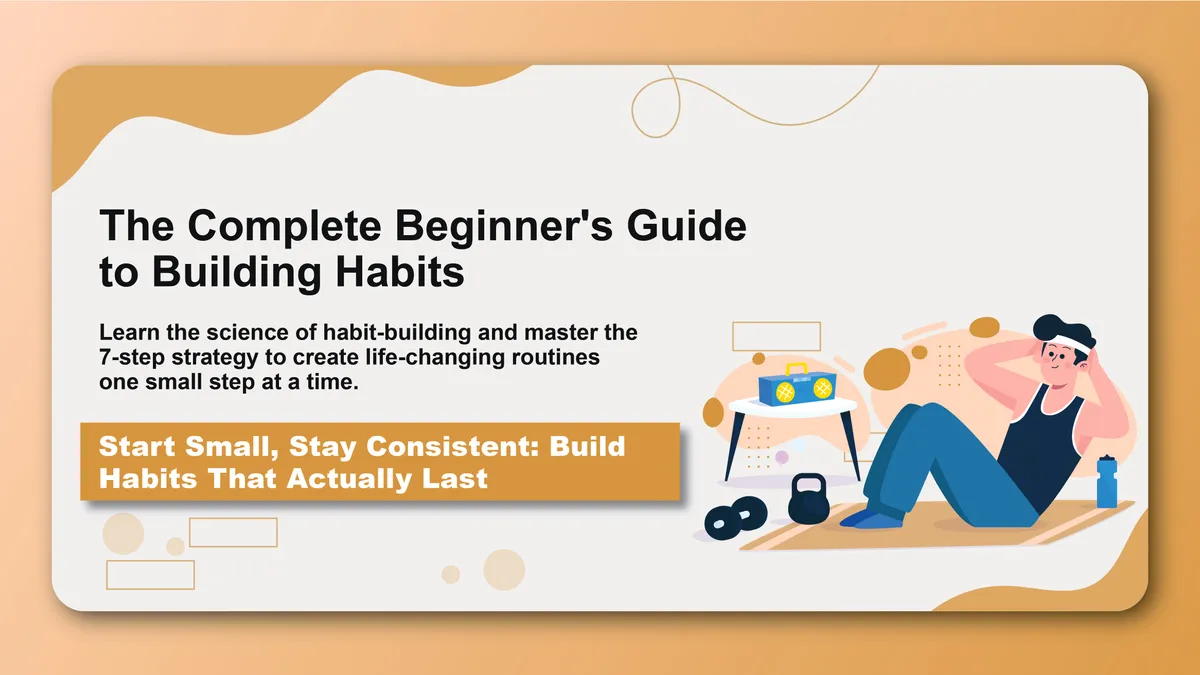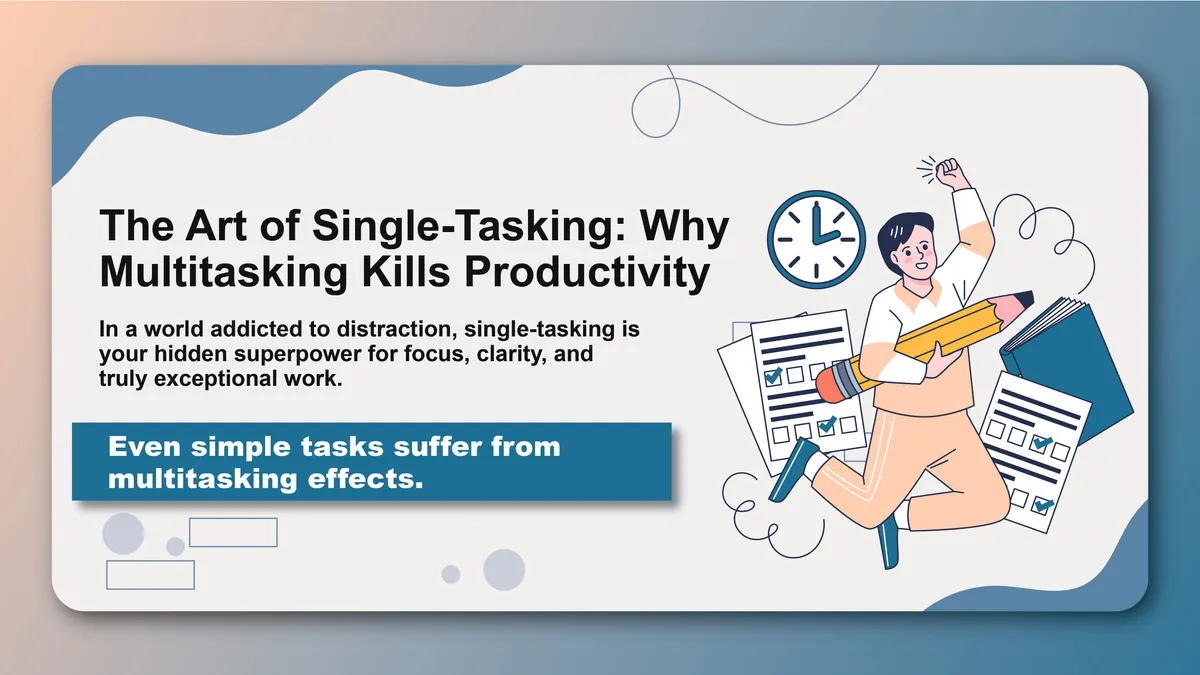Picture this: It's 6 PM on a Tuesday. You've just finished your "work day," but there's an important project deadline approaching. Your laptop sits on the counter, calling to you. Meanwhile, your family is in the next room, your workout clothes are still in the bag, and dinner needs to be prepared.
You feel torn. Should you work and feel guilty about neglecting your personal life? Or should you close the laptop and stress about the deadline? This is the work-life balance dilemma—a constant struggle to keep two essential parts of your life in perfect equilibrium.
But what if the entire concept of work-life balance is fundamentally flawed? What if the pursuit of perfect balance is creating more stress than it's solving?
After decades of trying to achieve this elusive balance, many successful professionals are discovering a different approach: work-life integration. Instead of treating work and life as opposing forces that must be carefully balanced, integration recognizes that these aspects of life can complement and enhance each other.
The Problem with Work-Life Balance
The Balance Myth
The False Dichotomy Work-life balance implies that work and life are separate, competing entities that must be carefully measured and counterbalanced. This creates an artificial division that doesn't reflect the reality of modern life.
The Impossible Standard True balance suggests equal time and attention to work and personal life. But life isn't symmetrical. Projects have deadlines, family members get sick, and priorities shift. Pursuing perfect balance often leads to guilt and frustration when the inevitable imbalance occurs.
The Static Assumption Balance implies a fixed state, but life is dynamic. Your needs, priorities, and circumstances change continuously. A balanced approach that worked last month might be completely inappropriate this month.
Why Balance Fails in Practice
Modern Work Reality
- Technology blurs the boundaries between work and personal time
- Remote work brings the office into your home
- Global teams require flexible scheduling
- Career advancement often requires periods of intense focus
- Economic uncertainty makes career dedication feel essential
Personal Life Complexity
- Family responsibilities don't follow a 9-to-5 schedule
- Personal growth requires time and attention
- Health and wellness need consistent investment
- Relationships require ongoing nurturing
- Personal interests and hobbies deserve space
The Guilt Trap When you inevitably spend more time on work during busy periods, you feel guilty about neglecting your personal life. When you focus on personal matters during work hours, you feel guilty about being less productive. This guilt cycle creates stress without solving the underlying challenge.
Understanding Work-Life Integration
The Integration Paradigm
Holistic Approach Instead of treating work and personal life as separate buckets that must be balanced, integration views them as interconnected aspects of a single, coherent life. The goal isn't balance—it's harmony.
Dynamic Flexibility Integration recognizes that different life phases require different approaches. Sometimes work demands more attention, sometimes personal matters take precedence. This flexibility reduces guilt and stress.
Synergistic Thinking Rather than seeing work and life as competing for resources, integration looks for ways they can support and enhance each other. Your professional skills can benefit your personal projects, and your personal experiences can enhance your professional capabilities.
Key Principles of Integration
Principle 1: Alignment Over Balance Focus on aligning your work and personal life with your values and long-term goals rather than achieving perfect time balance.
Principle 2: Flexibility Over Rigidity Create systems that can adapt to changing circumstances rather than trying to maintain fixed schedules and boundaries.
Principle 3: Quality Over Quantity Prioritize the quality of your presence and attention over the quantity of time spent in each area.
Principle 4: Synergy Over Separation Look for ways your work and personal life can complement and strengthen each other.
The Benefits of Work-Life Integration
Reduced Stress and Guilt
Elimination of Artificial Boundaries When you stop trying to maintain perfect separation between work and personal life, you eliminate the stress of constantly switching between "work mode" and "personal mode."
Acceptance of Natural Rhythms Integration acknowledges that some days, weeks, or months will be more work-focused, while others will prioritize personal matters. This acceptance reduces guilt and anxiety.
Flexibility in Scheduling You can attend your child's school play during traditional work hours without guilt, knowing you might handle some work tasks later in the evening when it's more convenient.
Enhanced Effectiveness
Optimal Energy Utilization Instead of forcing yourself to work during designated "work hours" when your energy is low, you can align your most important work with your peak energy times, regardless of when they occur.
Improved Focus When you're not constantly worried about maintaining perfect balance, you can be more present and focused in whatever you're doing.
Better Decision Making Integration allows you to make decisions based on what's most important overall, rather than trying to maintain artificial quotas of time and attention.
Greater Life Satisfaction
Authentic Living Integration allows you to be more authentic because you're not constantly switching between different versions of yourself for work and personal contexts.
Increased Engagement When work and personal life complement each other, you're more likely to be engaged and energized in both areas.
Long-term Sustainability Integration creates a more sustainable approach to managing life's demands because it's based on your actual needs and circumstances rather than external expectations.
Practical Strategies for Work-Life Integration
Strategy 1: Values-Based Decision Making
Identify Your Core Values
- What matters most to you in life?
- How do you want to be remembered?
- What kind of person do you want to be?
- What legacy do you want to create?
Align Decisions with Values When facing work-life decisions, ask:
- Which option best aligns with my values?
- How does this choice support my long-term goals?
- What would my best self do in this situation?
Create Value-Based Boundaries Instead of time-based boundaries (no work after 6 PM), create value-based boundaries (no work during quality time with family, no personal tasks during deep work sessions).
Strategy 2: Energy Management
Understand Your Energy Patterns
- When are you most creative and focused?
- What activities drain your energy?
- What activities restore your energy?
- How do different types of work affect your energy?
Schedule Based on Energy
- Do your most important work during peak energy times
- Schedule routine tasks during low-energy periods
- Plan energy-restoring activities when you need them most
- Balance energy-draining activities with energy-restoring ones
Cross-Pollination Use high-energy work time for challenging personal projects and vice versa. If you're energized by problem-solving at work, tackle personal challenges during that same energy peak.
Strategy 3: Flexible Scheduling
Time Blocking with Flexibility
- Block time for important activities without making them rigid
- Allow for movement and adjustment based on circumstances
- Create buffer time between different types of activities
- Plan for the unexpected
Batch Similar Activities
- Group similar work tasks together
- Batch personal errands and tasks
- Create themed days or time blocks
- Minimize context switching
Seasonal Adjustments
- Acknowledge that different seasons of life require different approaches
- Adjust your integration strategy based on current circumstances
- Communicate changes to family and colleagues
- Regularly reassess and modify your approach
Strategy 4: Boundary Management
Permeable Boundaries Instead of rigid walls, create permeable boundaries that can flex based on circumstances:
- Physical boundaries (dedicated workspace that can be used for personal projects)
- Temporal boundaries (flexible start and end times)
- Emotional boundaries (bringing positive energy from one domain to another)
Communication Boundaries
- Set clear expectations with family and colleagues
- Communicate your availability and response times
- Create systems for urgent vs. non-urgent communication
- Use technology to manage boundary transitions
Attention Boundaries
- Practice being fully present in whatever you're doing
- Minimize multitasking between work and personal activities
- Use mindfulness to transition between different types of activities
- Create rituals that help you shift focus
Implementation Framework
Phase 1: Assessment and Awareness
Current State Analysis
- How do you currently manage work and personal life?
- What causes you the most stress or guilt?
- Where do you see opportunities for better integration?
- What are your biggest challenges with the current approach?
Values Clarification
- What are your most important values?
- How do your current work and personal life choices align with these values?
- Where do you see misalignment?
- What would better alignment look like?
Energy Audit
- Track your energy levels throughout the day for a week
- Identify patterns in your energy and focus
- Note which activities energize you and which drain you
- Observe how work and personal activities affect each other
Phase 2: Design and Planning
Integration Goals
- What would successful integration look like for you?
- How would you know if your approach is working?
- What are your priorities for the next 3-6 months?
- How might these priorities shift over time?
Flexible Systems
- Design systems that can adapt to changing circumstances
- Create contingency plans for busy periods
- Build in regular review and adjustment processes
- Develop communication strategies for stakeholders
Support Structures
- What support do you need from family and friends?
- How can colleagues help make integration work?
- What tools and resources would be helpful?
- Who can provide accountability and encouragement?
Phase 3: Implementation and Adjustment
Gradual Implementation
- Start with small changes and build momentum
- Test new approaches in low-risk situations
- Gather feedback from family and colleagues
- Adjust based on what you learn
Regular Review
- Schedule weekly or monthly reviews of your integration approach
- Assess what's working and what isn't
- Make adjustments based on changing circumstances
- Celebrate successes and learn from challenges
Continuous Evolution
- Expect your approach to evolve over time
- Stay flexible and open to new strategies
- Learn from others who practice integration successfully
- Adapt to major life changes and transitions
Common Integration Challenges
Challenge 1: Perfectionism
The Problem: Trying to integrate perfectly instead of embracing the messiness of real life The Solution: Accept that integration is a practice, not a destination. Focus on progress, not perfection.
Challenge 2: External Expectations
The Problem: Others expecting you to maintain traditional work-life boundaries The Solution: Communicate your approach clearly and set appropriate expectations. Model integration successfully.
Challenge 3: Technology Overwhelm
The Problem: Technology making it difficult to create any boundaries The Solution: Use technology intentionally to support integration rather than letting it control you.
Challenge 4: Guilt and Judgment
The Problem: Feeling guilty for not following traditional balance advice The Solution: Remember that integration is about what works for you, not what others expect.
Integration for Different Life Stages
Early Career
- Focus on learning and growth opportunities
- Build skills that enhance both work and personal life
- Create systems that can scale with increasing responsibilities
- Establish patterns that support long-term success
Mid-Career with Family
- Prioritize quality time over quantity time
- Look for ways work skills can benefit family life
- Use family experiences to enhance professional capabilities
- Create flexibility for family needs and opportunities
Senior Career
- Focus on legacy and mentoring
- Integrate wisdom from personal experiences into professional work
- Use professional platform to support personal causes
- Prepare for eventual transition to retirement
Life Transitions
- Acknowledge that major changes require integration adjustments
- Be patient with yourself during adjustment periods
- Seek support from others who have navigated similar transitions
- View transitions as opportunities to refine your approach
Your Integration Action Plan
Week 1: Assessment
- Audit your current approach to work and personal life
- Identify your core values and priorities
- Track your energy patterns and stress points
- Note opportunities for better integration
Week 2: Design
- Envision what successful integration would look like
- Design flexible systems that align with your values
- Plan communication strategies for stakeholders
- Identify support needs and resources
Week 3: Implementation
- Start with small integration experiments
- Test new approaches in low-risk situations
- Gather feedback and adjust as needed
- Focus on progress, not perfection
Week 4: Refinement
- Review what's working and what isn't
- Make adjustments based on your experience
- Communicate with family and colleagues about your approach
- Plan for ongoing evolution and improvement
The Future of Work-Life Integration
Organizational Support
More organizations are recognizing that integration leads to better outcomes than forced balance:
- Flexible work arrangements
- Results-oriented work environments
- Support for employee whole-life wellness
- Recognition that personal fulfillment enhances professional performance
Technology as an Enabler
Technology can support integration when used intentionally:
- Tools that help manage energy and attention
- Systems that support flexible scheduling
- Communication platforms that respect boundaries
- Analytics that help optimize integration approaches
Cultural Shift
Society is gradually shifting from balance to integration:
- Recognition that rigid boundaries don't work for everyone
- Acceptance of non-traditional work arrangements
- Understanding that personal fulfillment enhances professional contribution
- Support for individual approaches to life management
Work-life integration isn't about having it all—it's about creating a life where your various roles and responsibilities complement and enhance each other. It's about being intentional with your choices, flexible with your approach, and authentic in your priorities.
The myth of work-life balance has caused enough stress and guilt. It's time to embrace integration—a more realistic, sustainable, and fulfilling approach to managing the complexity of modern life. Your future self will thank you for making this shift.
Ready to move beyond balance and create true work-life integration? Design your integrated life with Habityzer and build systems that support your whole-life wellness and success.



